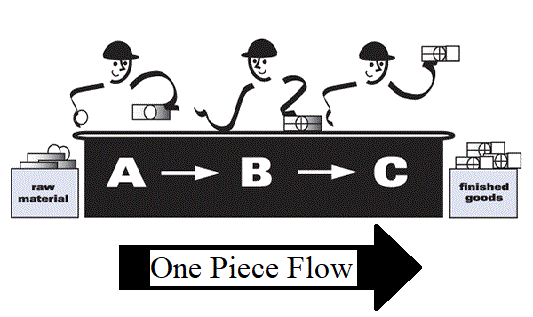Is One Piece flow the only way to maximize productivity?

Background
Lean Manufacturing / TPS has been spreading its philosophy and concepts across industries worldwide over the last two decades. By now, most practitioners have broadly come to a consensus on the advantages of implementing One Piece Flow which is widely recognized as a core Lean concept and considered as the Heart of a Lean process.
The biggest successes achieved by implementing flow manufacturing have happened in assembled products. Assembly and packing operations are known to be the most amenable to single piece flow and typically many of these already are already manufactured in such lines. The identification of bottleneck operations through process observation and reducing the cycle time of such operations through tools such as Operations Analysis and Line Balancing have given significant results in terms of productivity and throughput increase.
But is Flow the only and best way for an assembled product to be manufactured ? Does it always give the highest Value Adding Ratio leading to most effective resource utilization? These two small cases show us that there one other option which can be more effective than flow in certain circumstances.
Case 1 – Moulded Plastic toy
The toy industry is of a seasonal nature with peak sales in the festival seasons and the manufacturing level fluctuates accordingly with even zero production for 3-4 months. The manufacturing team was working to ramp up the productivity and throughput for a high demand toy. Current out put had peaked at 800 units per day on an assembly and packing line with 11 people and a running conveyor to transfer the product from station to station.
While the maximum cycle time recorded was 30 seconds per toy, a major Muda at each workstation was picking up the toy from conveyor and placing it back after completing the work. This pick and place took around 5-6 seconds and often interfered with the concentration of the operator. The team brainstormed and came out with two improvement options and both of these were tried out.
Option A – Line balancing and improvement
The belt conveyor was removed and tables were reoriented so that operators stood side by side in order of operation sequence. One person was redeployed as a material feeder to supply all the parts in front of the respective workstation. During the production trial, the output went up to 1000 units per day with the same team of people.
Option B – Single Person Workstation
Two single person workstations were set up next to each other – all six assembly operations were done by the first person and all four packing related operations by the second person. Each station had all required tools – for example the first station had two different fixtures and two pneumatic screw guns and all the assembly parts arranged in order of assembly sequence. The cycle time achieved was 75 seconds per toy in each station which translated to an output of 260 toys in a whole day for the 2 person cell.
In summary, the existing productivity of 72 toys/person/day went up to 90 toys in Option A and a much higher 130 toys using Option B. However, the team felt they were comfortable with Option A and went ahead with standardizing and sustaining the same.
Case 2 – Electronic product
The unit manufactures electronic products against customer orders mainly through government tenders. Hence, the business is again of a fluctuating nature with peaks and troughs depending on tender opening time and government priorities. While the business had tripled within a couple of years, margins were low and further eroded due to higher conversion costs.
The team was working on how to increase the productivity and lower cost so as to remain competitive. In the final assembly and packing line, 12 operators worked to deliver 2000 units per day. There were 8 such lines working in the company. The maximum cycle time was 12 seconds but this varied anywhere from 6- 10 seconds for the other operations. In this case as well, the team decided to try out two alternative methods.
Option A – Line balancing and workstation arrangement
Operators sat side by side in a long line in the existing process. The team made a U shaped line modifying one of the existing tables so that people could stand on both sides. After line balancing a smooth single piece flow was established delivering an output of 2000 units per day utilizing only 8 people.
Option B – Two person workstation (cell)
A small table was cutout from the existing long table – two workstations were created one on each side. The first operator does all assembly work and slides the assembled unit to the second operator who then completes the packing of unit, accessories and instruction cards. One such cell was able to deliver an output of 700 units per day.
In this case, the original productivity of 170 units/person/day went up to 250 in Option A while Option B gave 350 units. The team decided to run one line using Option A, one cell using Option B and continued running other lines in existing process. After a month, the teams met and concluded that Option B was the best. Within the next month they dismantled all existing assembly lines and replaced them with the two person workstations.
In both the above cases, the single person workstation or two person cell proved to be superior to the balanced one piece flow line. However, one team decided to stick to the tried and tested flow while the other team took the leap and completely changed the face of their manufacturing operations. This begs a few questions to be answered.
Why did these decisions happen? When can and should we apply each of these alternate concepts? What are the pros and cons of each?
…………….to be continued
